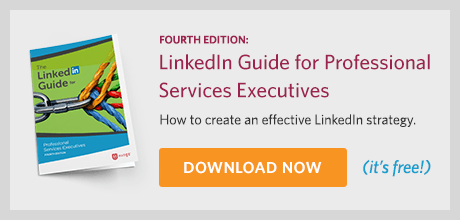Professional services firms have historically relied heavily on referrals to generate new business. On average, nearly 70% of buyers made a referral for their service provider. Interestingly enough, this number has decreased nearly 5% since 2013.
So what gives?
Even though recent research shows that clients are more willing to be referral sources for their service providers, they’re actually making fewer referrals. The key takeaway is the increase in alternative sources for information.
Prospects are using other methods to find service providers rather than asking a friend or a colleague for a referral. A recent study into the habits of professional services buyers showed that more than 70% leveraged digital techniques when evaluating their service providers.
The importance of a good old fashioned referral has not gone away. It’s just that digital marketing has outgrown traditional marketing in many important ways.
Download the LinkedIn Guide for Professional Services Executives
What does this have to do with LinkedIn?
Social media platforms, like LinkedIn, have revolutionized networking by providing online venues for building relationships and demonstrating relevant experience.
It just so happens to be that the number one criteria when a buyer is evaluating a professional service provider is understanding expertise through past performance (>35%). For a firm, and those representing the business, this experience can take the form of project examples, client testimonials, references and case studies, to name a few. Among a variety of features, LinkedIn provides a forum for all of these elements on a standard profile page and they need to be considered when developing yours.
If you aren’t yet maximizing social media, or are just taking your first steps into it, these types of data points may bring on a sense of nausea. After all, they reveal an inconvenient truth—if you want to grow your business, it’s time to get serious about social media marketing.
Make Your Move
So, how should you get started? Long-term you’ll discover that layering several social media platforms together as part of a complete digital strategy will give you the best results.
However, it’s best to begin with a solid foundation on the number one social media network for professional service firms—LinkedIn. With more than 575 million members world-wide, LinkedIn provides a platform for today’s workforce to provide thought provoking conversation on the latest ideas and trends, networking among a targeted list of peers and prospects, and best yet, a source for the new age of referral marketing.
After building a strong LinkedIn profile for each of your key business development team members, use the following three steps as a guide to take your game to the next level:
1) Win The Participation Trophy
You will meet people who have shared professional interests by joining in on the conversation. As a best practice, we recommend taking just 15 minutes out of your day to engage and participate in relevant LinkedIn News Feed and Groups discussions. Before choosing groups, decide who in your target audience you want to reach. Remember, in B2B sales there are usually multiple people who influence the buying decision.
You’ll want to find groups that appeal to each of the people who play a role in the decision-making process, broadening your reach. For example, if your firm helps both sales and marketing professionals, you may need to join both the ‘Sales Best Practices’ group and the ‘Content Strategy’ group.
To discover the groups in which your decision-makers and influencers participate, look at the profiles of clients and prospects, the types that you want more of. By scrolling down to the bottom and expanding on their Interests, you’ll find a list of groups to which they belong.

Check out these groups to determine which ones are the most active. Ask yourself, Is there actual conversation going on?
Or is this group just a receptacle for someone posting an offer to provide outsourced SEO for $199/month… every 15 minutes?
The more engagement that is present, the more likely it is that you’ll be able to find ones to which you can add value and show your thought leadership and meet new prospects.
You can get your feet wet in a group by answering questions or commenting on topics other group members have raised. Alternatively, to gain even greater visibility, you can initiate a discussion.
As noted, just like with live networking, leading a discussion with a sales pitch will put a quick end to conversations (and might even get you banned from a group). So, if you link to content to start a conversation, don’t be self-promotional. Instead, mix other blog posts, articles, and content in with content your firm produces. A good guideline is four pieces of content curated from other sources to one of your own.
By bringing up relevant topics and discussing the key issues your prospects and clients are grappling with, you can establish your expertise as a thought leader and best demonstrate that all important expertise.
2) Make The Next Steps Easy
There are several ways that LinkedIn can also drive traffic to your site without spending a dime. And we have seen that more traffic leads to more conversions, such as prospects downloading gated content and completing contact forms, which results in more new business opportunities. How does it work:
- First, visitors may be directed to your website from the group discussions. At Hinge, we’ve found that posts that stimulate conversations will drive a noticeable amount of traffic to our website, especially to the source of the content.
- Second, when a prospect completes a search for a provider who can help them to solve a problem, one of your company’s leaders may rise to the top of the search results. If his or her profile includes a link to your website in the ‘Contact Info’ section, as it should, the searcher is just one click away from your site.
- You can post your content in LinkedIn’s news feed and it will be shared with all of your connections who may read and click through to your website. Bonus points if you can get your colleagues to throw you a like or even help start the conversation! Remember- you’re all in this together.
- Lastly, if you’re willing to make an investment, you can take advantage of LinkedIn’s sponsored updates and pay-per-click ads that allow you to precisely target your audience. This works best when that target audience is known, particularly through research.
People who come to your website from LinkedIn do so with some familiarity with your firm and its leaders. Thus, when they arrive, they’re more likely to convert into a qualified lead.
3) Make New Friends (But Keep the Old)
If you’ve done your research and marketing legwork, you have outlined the qualities of your ideal client. Most likely, you’ll find these potential prospects on LinkedIn.
However, you’ll need to connect with them to start a direct conversation. The best way to do this is to find a connection that you have in common and ask him or her to introduce you virtually. Make this process as easy as possible for your contact by explaining the value you offer their connection and including brief email language for the introduction.
If you’re all in and want to take it to the next level, consider investing in LinkedIn’s Sales Navigator. This tool allows you to search more efficiently and zero in on the right prospects and decision-makers. Users can save lists of target accounts and leads as well as get notifications of potential new matches.
The service also comes with a hefty amount of InMails, direct messages that LinkedIn guarantees they’ll deliver. And if you send easy-to-read InMails that promise a benefit to the reader, they may start a conversation that leads to a sale.
Download the LinkedIn Guide for Professional Services Executives
Using LinkedIn for business development is a powerful ally in the fight for business development. You can build relationships that are not limited by geography, become known as a visible expert or thought leader, and increase web traffic and conversions.
LinkedIn is the primary social network for professional services firms – it’s where your future clients are sharing relevant information and discussing industry trends. By participating in the conversation, sharing relevant content, and connecting directly with those who match your client profile, you can reach your target audience easily and efficiently.
A Closing Thought
We can all recognize the importance of referrals to bringing in new business. But it’s important to recognize that referrals don’t only come from clients and those who have experience of working with us. Non-client referrals are just as significant and come to us through venues such as speaking and networking events, and, through social media.
The research shows that 17% of non-client referrals happen through firms’ activity and subsequent visibility in social media channels. As a viable marketing strategy and pathway to new business, social media, and LinkedIn in particular, is well past being “something to consider.”
It’s a must for business development in professional services.

How Hinge Can Help
Hinge has developed a comprehensive plan, The Visible Firm® to address these challenges and more. It is the leading marketing approach for delivering greater visibility, growth, and profits. This customized program will identify the most practical offline and online marketing tools your firm will need to gain new clients and reach new heights.
Additional Resources
- Download a free copy of our SEO Guide for Professional Services to create an SEO plan to make your firm easily found online.
- For more hands-on help on becoming the next social media power user, register for our Mastering Social Media course, or get it included with Hinge University Pro today.
- Get a copy of our Online Marketing for Professional Services book to learn techniques that will generate more leads and increase awareness of your firm.


